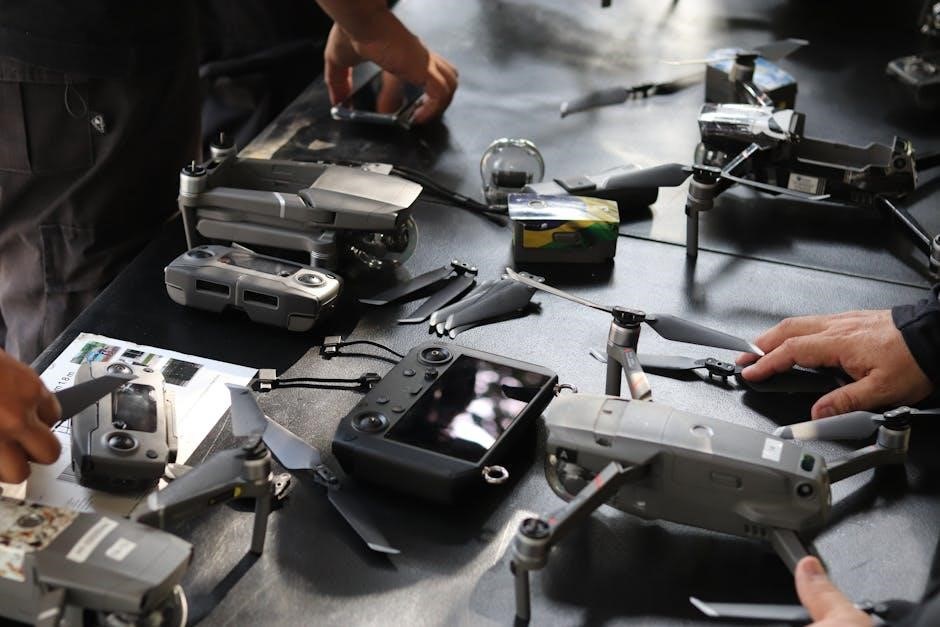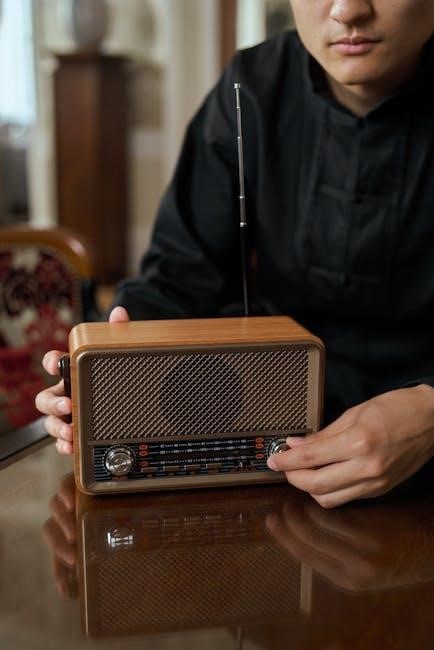EasySMX controller manuals provide essential guides for models like X10, X05, ESM-9013, and Arion 9110. They detail setup, features, troubleshooting, and customization options, ensuring optimal gaming experiences. Downloadable as PDFs online.

1.1 Overview of EasySMX Controllers
EasySMX controllers are versatile gaming peripherals designed for compatibility with PC, Nintendo Switch, Android, and iOS devices. Popular models include the X10, X05, ESM-9013, and Arion 9110, each offering unique features tailored for enhanced gaming experiences. These controllers boast ergonomic designs, intuitive button layouts, and advanced functionalities like Turbo mode, RGB lighting, and programmable buttons. They support both wired and wireless connections, with options like Bluetooth or 2.4GHz receivers for seamless gameplay. Many models also feature vibration feedback, adjustable joysticks, and customizable profiles to suit individual preferences. Additionally, some controllers include rechargeable lithium-ion batteries, providing extended playtime and convenience. Whether for casual or professional gaming, EasySMX controllers are known for their durability, versatility, and user-friendly interfaces, making them a popular choice among gamers worldwide.
1.2 Importance of Reading the Manual
Reading the EasySMX controller manual is crucial for unlocking the full potential of your gaming experience. The manual provides detailed instructions for setting up your controller, pairing it with devices, and accessing advanced features like Turbo mode, RGB lighting, and programmable buttons. It also offers troubleshooting tips for common connectivity issues, ensuring smooth gameplay across platforms such as PC, Nintendo Switch, Android, and iOS. By understanding the button layout, customization options, and maintenance tips, users can optimize their controller’s performance and extend its lifespan. Additionally, the manual includes safety guidelines, warranty information, and compliance details, which are essential for proper usage. Whether you’re a new user or upgrading from an older model, the manual serves as an indispensable guide to mastering your EasySMX controller effectively.
1.3 Where to Find EasySMX Controller Manuals
EasySMX controller manuals are readily available through various channels. The official EasySMX website provides downloadable PDF versions for models like the X10, X05, and Arion 9110. Additionally, manuals can be found on third-party platforms such as ManualsLib, ManualsDir, and Device.Report. Many retailers, including Amazon and eBay, include manuals with product purchases or offer them as downloadable resources. Specific models, like the ESM-9013, are hosted on platforms like the Internet Archive. Users can also visit the EasySMX Discord community or forums for direct links. For convenience, some manuals are embedded within product listings or provided via email upon request. Always ensure to download from trusted sources to avoid unauthorized content. These resources ensure easy access to setup guides, troubleshooting tips, and feature details for optimal controller use.

Button Layout and Design
EasySMX controllers feature intuitive button layouts with joysticks, directional pads, triggers, and bumpers. Models like X10, X05, and Arion 9110 include programmable buttons, Turbo modes, and RGB lighting controls for enhanced functionality.
2.1 EasySMX X10 Button Layout
The EasySMX X10 controller features a sleek and ergonomic design with a logical button layout for seamless gaming experiences. The controller includes a left joystick, right joystick, and directional pad for precise control. The face buttons (A, B, X, Y) are arranged in a standard diamond layout, while the bumpers and triggers are located on the top for easy access. Additional buttons include the Start, Back, HOME, and Settings buttons for quick navigation. The TYPE-C charging port is positioned at the top, and the RGB indicator light provides visual feedback. The controller also includes a reset hole, programming keys (M1, M2), and a mode toggle button for customization. The Turbo button allows for rapid-fire inputs, and the vibration motors enhance immersion. This layout ensures intuitive operation, catering to both casual and professional gamers.
2.2 EasySMX X05 Button Layout
The EasySMX X05 controller offers a versatile and intuitive button layout designed for multi-platform compatibility. The controller features dual analog joysticks, a directional pad, and face buttons (A, B, X, Y) arranged in a standard diamond configuration. The bumpers and triggers are located on the top, providing easy access for gaming; Additional buttons include the HOME, Start, and Settings buttons for quick navigation and customization. The controller also includes a mode toggle button to switch between different connection modes, such as PC, Switch, or mobile devices. The Turbo button allows for rapid-fire inputs, while the RGB lighting adjustment buttons enable users to personalize their gaming experience. The ergonomic design ensures comfort during extended play sessions, and the button layout is optimized for both casual and professional gamers. The X05 manual provides detailed diagrams and descriptions for each button, ensuring users can fully utilize its features.
2.3 EasySMX ESM-9013 Button Layout
The EasySMX ESM-9013 controller features a well-organized button layout tailored for enhanced gaming performance. The left side includes a ergonomic joystick and a directional pad, while the right side houses another joystick and four face buttons (A, B, X, Y). The top section contains bumpers, triggers, and a reset hole for quick adjustments. Additional buttons like HOME, Start, and Settings provide easy access to menu functions. The controller also includes a Turbo button for rapid-fire inputs and programmable keys (M1, M2) for custom macros. The ergonomic design ensures comfort and intuitive control placement, making it suitable for both casual and professional gamers. The RGB indicator light and TYPE-C charging port are strategically positioned for convenience. The ESM-9013 manual includes detailed diagrams to help users familiarize themselves with the layout and optimize their gaming experience.
2.4 EasySMX Arion 9110 Button Layout
The EasySMX Arion 9110 controller offers a sleek and intuitive button layout designed for seamless gaming experiences. The left side features a precision joystick and a directional pad, while the right side includes another joystick and four face buttons (A, B, X, Y) arranged in a familiar diamond pattern. The top section houses bumpers, triggers, and a reset hole for easy access. Additional buttons such as HOME, Start, and Settings are strategically placed for quick menu navigation. The controller also includes a Turbo button for rapid-fire inputs and programmable keys (M1, M2) for custom macros. The ergonomic design ensures comfortable grip and intuitive control placement. The RGB indicator light provides visual feedback, and the TYPE-C charging port is conveniently located at the top. The Arion 9110 manual includes detailed diagrams to help users master the layout and optimize their gaming sessions. This layout caters to both casual and professional gamers, enhancing overall performance and satisfaction.

Connecting Your EasySMX Controller
EasySMX controllers offer versatile connectivity options, supporting PC, Nintendo Switch, Android, and iOS devices. Users can connect via wireless modes, Bluetooth, or USB, ensuring a seamless gaming experience across compatible devices.
3.1 Connecting to a PC
Connecting your EasySMX controller to a PC is a straightforward process. For wireless connection, press the HOME button to turn on the controller, and the LED indicators will start flashing, indicating pairing mode. Insert the provided USB receiver into your PC’s USB port, and the controller will automatically pair with your device. Alternatively, you can connect via Bluetooth by enabling Bluetooth on your PC and selecting the controller from the available devices list.
For a wired connection, use the included USB-C cable to connect the controller directly to your PC. The controller will be recognized automatically, and you can start gaming immediately. Ensure your PC has the latest drivers installed for optimal compatibility. If you encounter connectivity issues, restart both the controller and PC or reset the controller using the reset hole. Refer to the manual for specific instructions tailored to your EasySMX model.

3.2 Connecting to Nintendo Switch
To connect your EasySMX controller to a Nintendo Switch, follow these steps. First, ensure the controller is in Switch mode by toggling the slide switch on the back to the “NS” position. Press and hold the HOME button for 3 seconds to turn on the controller. The LED indicators will flash, indicating pairing mode.
Next, power on your Nintendo Switch and navigate to the “Controllers” menu. Select “Change Grip/Order” and choose the option to pair a new controller. Once the controller appears in the list of available devices, select it to complete the pairing process. Your EasySMX controller is now connected and ready for use with your Switch. Ensure your controller is fully charged or plugged in via USB for uninterrupted gaming sessions. If connectivity issues arise, reset the controller using the reset hole or restart both devices. Refer to your specific model’s manual for additional troubleshooting steps.
3.3 Connecting to Android Devices

To connect your EasySMX controller to an Android device, start by enabling Bluetooth on your device. Toggle the slide switch on the back of the controller to the “BT” mode. Press and hold the HOME button for 3 seconds to turn it on. The LED indicators will flash, indicating pairing mode.
Open your Android device’s Bluetooth settings and search for available devices. Select the EasySMX controller from the list. If prompted, enter the pairing PIN (typically 0000). Once connected, the LED indicators will stop flashing. For USB connections, use a USB-C cable or an OTG adapter to plug the controller directly into your Android device. Ensure your device supports USB OTG for proper functionality. If connectivity issues occur, reset the controller using the reset hole or restart both devices. Refer to your specific model’s manual for additional troubleshooting steps or configuration options.
3;4 Connecting to iOS Devices
To connect your EasySMX controller to an iOS device, ensure your controller supports Bluetooth connectivity. Toggle the slide switch on the back to the “BT” mode. Press and hold the HOME button for 3 seconds to activate pairing mode—the LED indicators will flash.
On your iOS device, navigate to Settings > Bluetooth and enable Bluetooth. Select the EasySMX controller from the list of available devices. For some models, you may need to enter a pairing PIN (typically 0000). Once connected, the LED indicators will stabilize.
For compatibility, ensure your iOS device runs on version 13.0 or later. Some EasySMX controllers, like the X05, are MFi-certified, ensuring seamless integration with iOS devices. If connectivity issues arise, restart both devices or reset the controller using the reset hole. Refer to your controller’s manual for specific instructions or additional troubleshooting steps.

Features and Customization Options
EasySMX controllers offer customizable features like Turbo Mode, RGB lighting adjustment, and programmable buttons for enhanced gaming experiences. These options allow users to tailor their setup to personal preferences.
4.1 Turbo Mode Setup
Turbo Mode on EasySMX controllers enhances gameplay by enabling rapid button presses; To activate, press and hold the Turbo button for 3 seconds until the LED flashes. Use the left and right directional pads to adjust speed levels. The Turbo function supports A/B/X/Y buttons and triggers, allowing for faster actions in games. For example, in shooting games, Turbo Mode can enable quick firing. To deactivate, press the Turbo button again. Ensure the controller is in the correct mode (e.g., XInput or DirectInput) for Turbo to function properly. Refer to the manual for specific button assignments and mode settings. This feature is particularly useful for competitive gaming, offering a customizable edge. Always test Turbo Mode in a game to confirm proper operation and adjust settings as needed for optimal performance.

4.2 RGB Lighting Adjustment
EasySMX controllers feature customizable RGB lighting, allowing users to personalize their gaming experience. To adjust the lighting, press the HOME button to cycle through predefined modes, such as static, breathing, or cycling colors. Use the Mode Toggle button to switch between lighting speeds and brightness levels. Some models enable programming custom RGB patterns via software. For example, press and hold the Settings Button while connecting the controller to access the lighting menu. Adjustments can also be made using the controller’s companion app, if available. The RGB lighting adds a stylish touch to gameplay and can be synchronized with other gaming peripherals. Ensure the controller is in the correct mode (e.g., XInput or DirectInput) for RGB settings to apply. Refer to the manual for specific button combinations and app instructions to customize the lighting to your preference, enhancing both aesthetics and immersion during gameplay.
4.3 Programmable Buttons and Macros
EasySMX controllers offer programmable buttons and macro functions, allowing users to customize their gaming experience. The M1 and M2 buttons can be programmed to perform complex actions or macros, such as combining multiple button presses into a single command. To program these buttons, press and hold the desired button while holding the HOME button for 3 seconds. Use the directional pad or joystick to assign the desired function. Macros can be saved by pressing the Mode Toggle button. Some models also support Turbo mode, which can be activated using the Turbo button. The programmable buttons enhance gameplay efficiency, especially in competitive scenarios. Refer to the manual for detailed instructions on setting up macros and customizing button functions for optimal performance. This feature is particularly useful for gamers seeking a personalized control scheme tailored to their preferences and playstyle.

Troubleshooting and Maintenance
Troubleshoot connectivity issues by resetting the controller or pairing it again. Clean buttons and joysticks regularly for optimal performance. Maintain battery health by avoiding overcharging and storing the controller properly.
5.1 Common Connectivity Issues
Common connectivity issues with EasySMX controllers include pairing problems, dropped connections, and LED indicator malfunctions. Ensure the controller is in the correct mode (BT, NS, or PC) for your device. Reset the controller by inserting a pin into the reset hole if it fails to pair. For wireless models, check that the receiver is properly plugged into your PC or console. If using Bluetooth, ensure your device supports the correct profile and is within range. Restart both the controller and the device to re-establish a connection. Check for firmware updates, as outdated software can cause compatibility issues. Clean the charging port to prevent power supply problems. If issues persist, consult the manual or contact EasySMX support for further assistance; Regular maintenance, such as updating drivers and cleaning components, can help prevent connectivity problems. Always refer to the troubleshooting section of your specific model’s manual for detailed solutions.

5.2 Controller Reset Procedures
Resetting your EasySMX controller can resolve firmware issues or restore default settings. To reset, locate the small reset hole on the back or bottom of the controller. Use a pin or thin object to gently press and hold the reset button inside the hole for 5-10 seconds. Release and wait for the controller to power off. Turn it back on and attempt pairing again. This process resets all custom settings, including button mappings and RGB configurations, to factory defaults. Perform a reset if the controller fails to connect, experiences lag, or behaves erratically. After resetting, reconnect the controller to your device and reconfigure settings as needed. Regular resets can help maintain optimal performance. If issues persist, refer to the manual or contact EasySMX support for further assistance. Always back up custom settings before performing a reset to avoid losing your configurations.
5.3 Battery Maintenance Tips
Proper battery maintenance ensures longevity and optimal performance for your EasySMX controller. Charge the controller using the provided TYPE-C cable and avoid overcharging, as it may degrade battery health. If the controller is not in use for an extended period, store it with a partial charge (around 50%) to prevent deep discharges. Clean the charging port regularly to maintain good connectivity and avoid damage. Avoid exposing the controller to extreme temperatures, as this can affect battery life. If you notice reduced battery performance, reset the controller or update the firmware to resolve potential issues. Always use the original charger or a compatible alternative to prevent overheating. For controllers with removable batteries, ensure they are securely seated to maintain proper power supply. By following these tips, you can extend the lifespan of your EasySMX controller and enjoy uninterrupted gaming sessions.
This guide provides comprehensive insights into EasySMX controller manuals, covering setup, features, and troubleshooting. For further assistance, visit the official EasySMX website or download PDF manuals from trusted sources online.
6.1 Summary of Key Points
The EasySMX controller manuals offer detailed guidance for models such as the X10, X05, ESM-9013, and Arion 9110. These manuals cover essential aspects like button layouts, connectivity options, and customization features. Users can learn how to set up their controllers for PC, Nintendo Switch, Android, and iOS devices, ensuring seamless gaming experiences. The guides also explain advanced features like Turbo Mode, RGB lighting adjustments, and programmable buttons, allowing for personalized configurations. Troubleshooting sections address common issues, such as connectivity problems and battery maintenance, providing practical solutions. Additionally, the manuals include reset procedures and tips for extending controller longevity. By following these resources, users can maximize their controller’s performance and enjoy a more immersive gaming experience. For further assistance, official EasySMX websites and support forums offer additional resources and updates.
6.2 Where to Find More Information
For additional details about EasySMX controller manuals, visit the official EasySMX website, which offers downloadable PDF manuals for models like the X10, X05, and Arion 9110. You can also explore support forums and community discussions where users share tips and solutions. Third-party platforms like ManualsLib and ManualsDir provide comprehensive collections of EasySMX manuals. Additionally, specific resources such as ManualsPlus offer detailed guides for troubleshooting and customization. For model-specific instructions, refer to the EasySMX Discord club or official FAQ sections. These resources ensure you have access to the latest updates and detailed instructions for optimizing your controller’s performance. Always verify the source to ensure accuracy and relevance to your device.
